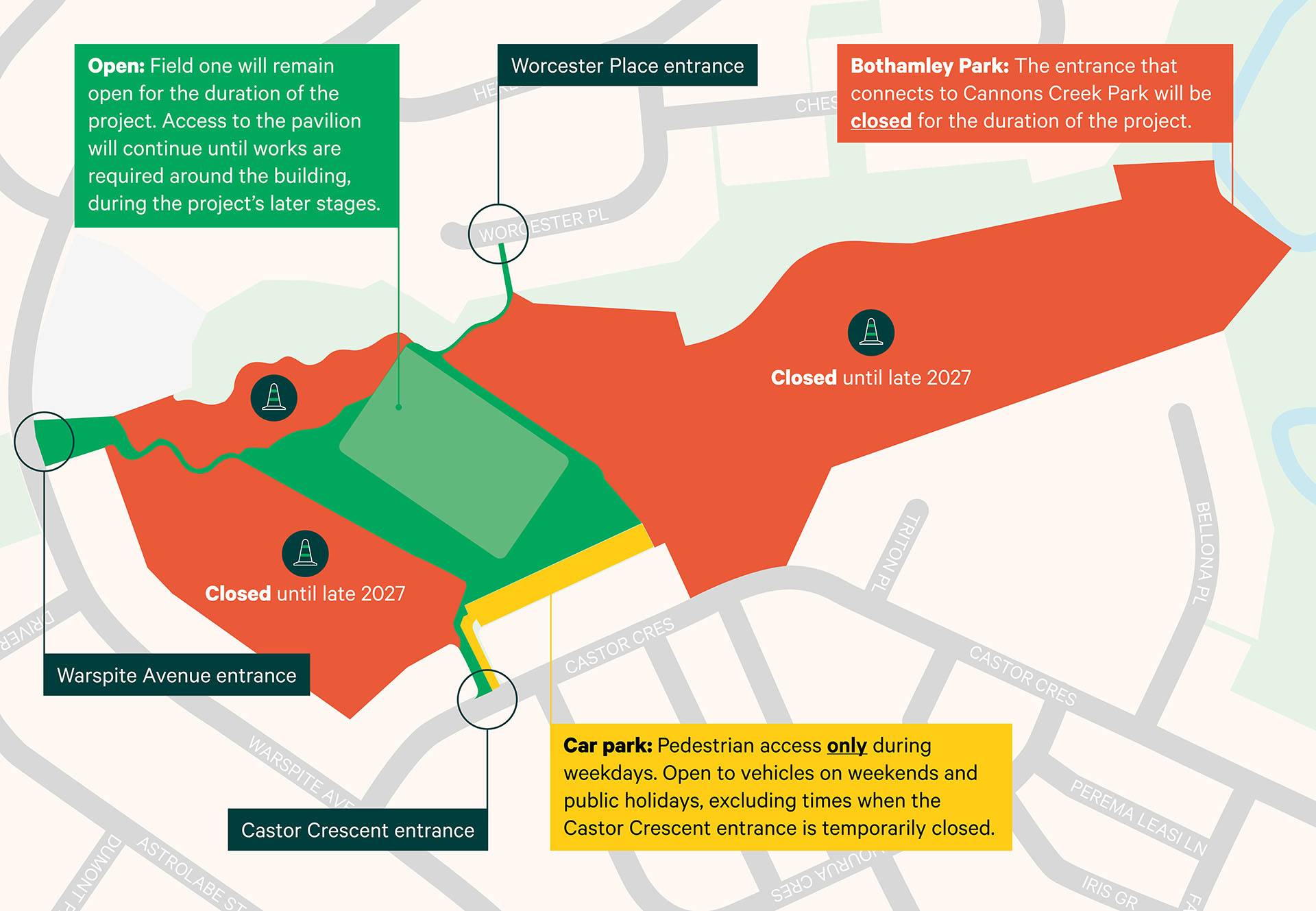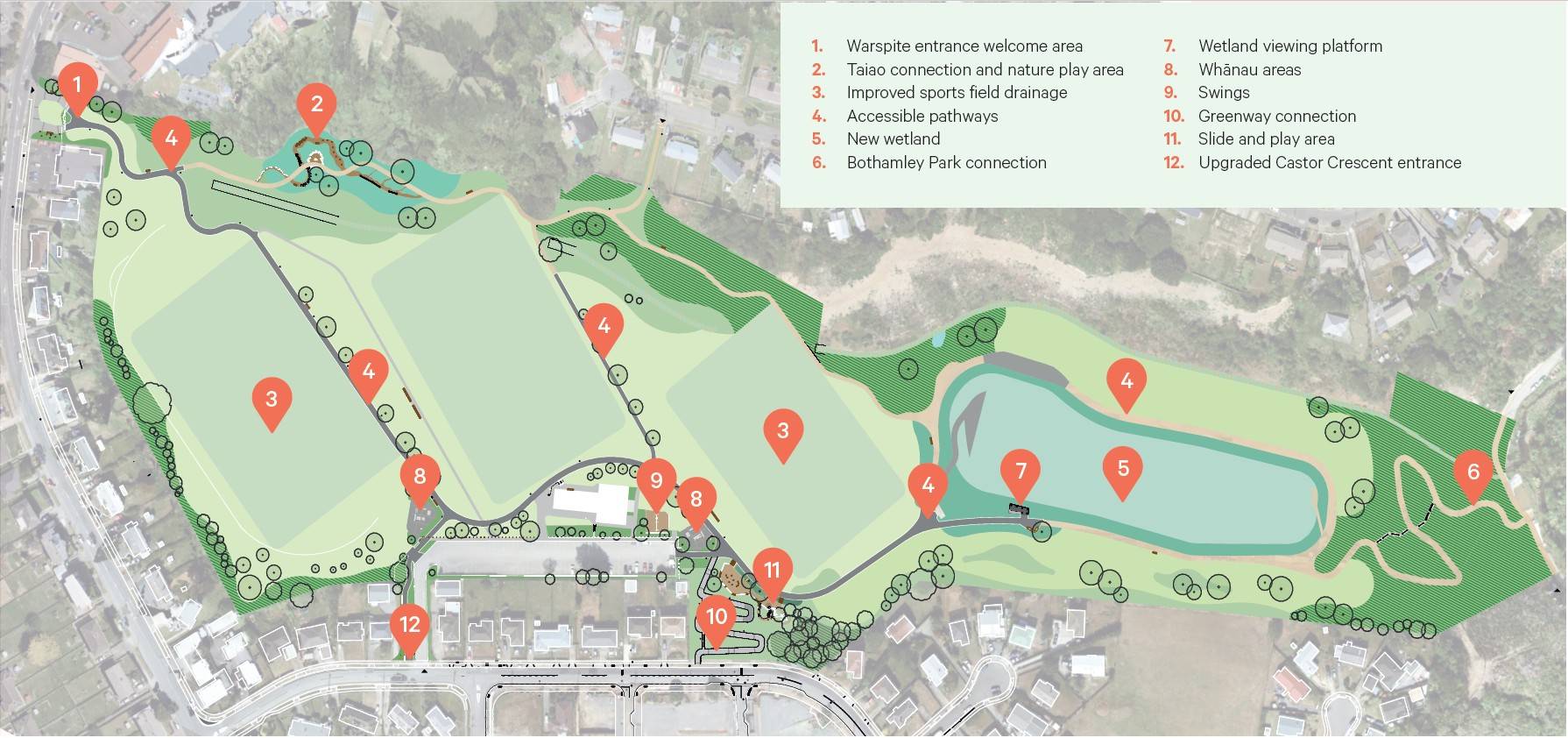Improving te taiao (the environment) is a priority for eastern Porirua, and this project will help us achieve it. When work is completed in late 2027, the upgraded park will include:
- Three sports fields with improved drainage to reduce the effects of flooding
- A new wetland, made by converting the bottom (northern end) field, to improve water quality in Kenepuru Stream and Te Awarua-o-Porirua
- New stormwater and wastewater pipes through Cannons Creek Park to Warspite Avenue
- New, additional recreational spaces around the park
Park access during construction

Parts of Cannons Creek Park are closed from 7 November 2025 until late 2027, but the pavilion and field one remain open for public use.
JFC (John Fillmore Contracting) is our lead contractor for practical delivery of the project, and their teams will be working from Monday to Saturday, between 7am and 6pm. Signage and fencing will be in place to keep everyone safe during construction, and we ask anyone accessing field one or the pavilion during work hours to please obey all safety measures and keep to dedicated walkways.
Field one and the pavilion will remain accessible on foot from Worcester Place, Warspite Avenue and Castor Crescent, but sometimes we may need to temporarily close an entrance. When this happens, signs will direct park users to a nearby entrance that remains open.
The Bothamley Park entrance will be closed for the duration of the project, and the Castor Crescent car park will be pedestrian access only during weekdays. It will be open to vehicles on weekends and public holidays, excluding times when the Castor Crescent entrance is temporarily closed.
Our new community spaces

As well as our new wetland, improved sports field drainage and upgraded infrastructure, Cannons Creek Park will be home to a range of new features, including:
- A welcome area at Warspite Avenue, with information about the park’s features and other local amenities.
- Whānau areas to connect and be active – from sharing kai and relaxing to spaces for climbing, sliding, jumping and swinging.
- Signs, storyboards and art that celebrates our local history, stories and the cultural identity of our people and communities throughout eastern Porirua.
- An outdoor classroom designed to encourage learning in the natural environment.
- A natural play area for connection to te taiao (the environment), with signs that tell the park’s natural history, information about local insects and wildlife, and play areas, native planting and kai forests.
Our green areas, wetland and new spaces will be linked by accessible shared paths, and no space will be taken away from the three upgraded sports fields.
See how some of these spaces may look when completed:
How we got here
Community feedback in late 2021 showed support for a proposed wetland at the bottom of Cannons Creek Park to improve water quality and reduce flood risk to nearby homes. We then asked for additional feedback in late 2022.
When our infrastructure experts were finalising the design of our wetland during 2023, Te Rā Nui held a series of workshops with subject matter experts, a community design group made up of park users and locals, Ngāti Toa Rangatira, Porirua City Council and local school students. Through this engagement process, we worked collaboratively to create a concept design for new recreational spaces and well-lit shared paths to ensure everyone can use and enjoy Cannons Creek Park.
Since then, we’ve worked with our project partners to finalise planning and prepare for construction, with on-site work beginning in November 2025.
Timeline
Late 2027 – Construction and replanting work in Cannons Creek Park is complete.
Late 2025 – Construction begins on wetland and park upgrades.
Mid 2025 - Designs are finalised and procurement process begins for wetland and park upgrades.
Early 2025 – Wetland design and application approved, and replanting work to start.
Late 2024 – Porirua City Council approves Reserve Act application.
Mid-late 2024 – Porirua City Council begins review of Reserves Act application and holds public consultation.
Mid 2024 – Reserve Act and resource consent applications lodged with Porirua City Council.
Late 2023 – early 2024 – Wellington Water and Porirua City Council review preliminary reports on the proposed wetland. This is followed by an environmental assessment of the area to support the consent application.
Mid-late 2023 – Further engagement informs six key community spaces in Cannons Creek Park, including themes like accessibility, better connections, lighting for safety, and areas for the community to gather, play and learn.
Late 2022–early 2023 – Community feedback is combined with additional investigation work to finalise designs for resource consent application.
Mid 2022 – Round two community engagement, focussing on some key spaces to ensure they would reflect aspirations for the park.
Early 2022 –Cannons Creek Park wetland concepts are designed.
Late 2021 – Round one community engagement to gauge community support for the creation of a wetland.
2020 – 2021 – A series of investigations are held to learn more about water quality in the area and ways we could improve this for the community.
Frequently asked questions
-
What has changed to the wetland and Cannons Creek Park design plans since community engagement in 2022?
On review of community feedback and the proposed design, we saw an opportunity to rethink how we could enhance the community’s connection with Cannons Creek Park. To help create new spaces in the park that celebrate the community's culture, heritage, and identity, we continued engaging for an additional six months in 2023. This included bringing Ngāti Toa Rangatira, local school students and a group of community members together, with the support of landscape architects and Porirua City Council.
The group’s work involved exploring ways we could include our local history into Cannons Creek Park and Wetland. As a result, our resource consent application included the construction of a wetland, accessible paths, lighting, and new recreational spaces that will help support local kaitiakitanga (guardianship) and enhance the community’s connection with Cannons Creek Park and te taiao (the environment).
-
What will Cannons Creek Park look like after all the work has been completed?
The upgrades at Cannons Creek Park will include:
- Three sports fields with improved drainage, helping to ensure they can be played on more often
- A wetland on the bottom field (at the northern end of the park), to improve water quality and biodiversity
- Larger and more resilient wastewater and stormwater pipes to support current and future generations living in eastern Porirua
- New recreational spaces around the park and accessible, well-lit paths to help everyone move through the sports fields, new spaces, Bothamley Park, Warspite Avenue and Castor Crescent.
-
What will the new recreational spaces include, and will they take away any of the sports fields?
As part of Cannons Creek Park upgrades, the bottom (northern end) field will be converted into a wetland. No space will be taken away from the three remaining fields when we create new spaces for the community to use and enjoy. They include:
A welcome area – people entering the park from Warspite Avenue will be welcomed by signs that provide information Cannons Creek Park features, along with information about other local amenities. We’re also investigating options to include local sculptures or artwork that enhances visitors’ connections with the eastern Porirua community.
Whānau area (connect) – whether a small or a larger group, this space is designed for gathering, sharing kai or relaxing together. It will include facilities and accessible tables, a space for picnics and to put up a gazebo or sit in the shade.
Whānau area (active) – a place where whānau can come to be active and play. From climbing, sliding, jumping or swinging, this area will work with the existing slope to provide lots of active fun. It will also include a shaded space for park users to rest and watch their friends and whānau play, and to prepare and share kai.
Celebration and identity – this space will celebrate our local history, stories and the cultural identity of our people and communities throughout eastern Porirua. It will include signs, storyboards, local sculptures and art, along with seating on the grassed area (including accessible seating), and shaded areas.
Education – an outdoor classroom designed to encourage learning in the natural environment. This space includes seating, places to put down mats, shaded areas and spaces to teach tamariki or visitors, and information boards.
Connection to te taiao (the environment) – this space is designed to enhance community and visitor connections with te taiao. It will include a range of signs that tell the park’s natural history, information about insects and wildlife that park users may see in the area, nature play areas, native planting and kai forests. As we look to replant in the area, there will be future opportunities for the community to get involved and create connections.
-
Will my rates increase to pay for the upgrades?
No. The Cannons Creek Park and Wetland Project will be paid for by Te Rā Nui, utilising central Government funding from various sources. Rates are set by the Porirua City Council, so these won’t be affected by the upgrades.
-
Will any of the fields remain open while you construct the wetland?
There will be some temporary disruption during construction, but we will minimise this as much as we can and ensure everyone can still access field one.
-
How long will it take to complete the park upgrades in Cannons Creek Park?
It will take around two years to construct the new wetland, upgrade the stormwater and wastewater pipes through Cannons Creek Park, create the new community spaces and plant around 20,000 native plants. Construction starts in late 2025 and will be completed around late 2027.
-
How will this space be accessible?
Even though Cannons Creek Park has several hills, we’ve designed our shared paths to be accessible for all community members to use, from walking and cycling to mobility scooters, wheelchairs, and whānau pushing a pram.
-
What is a wetland?
Wetlands are areas with plants that are often covered by water. They act like the kidneys of the Earth, because their plants and vegetation clean the water that flows into them and improves its quality downstream.
Wetlands that are man-made, like the one we’re building in Cannon’s Creek Park, are designed to trap soil, filter and remove contaminants before water flows downstream. They can provide homes for fish and aquatic life, which – along with the native grasses and flaxes planted along their edges – supports growing habitats for native birds, lizards, and insects.
As well as supporting water management, wetlands can be designed to include recreational and community benefits, such as new paths for walking or biking, as well as spaces to learn and connect.
-
Who will deliver the work?
We’re working with a range of partners to deliver the Cannons Creek Park and Wetland project – Studio Pacific Architecture have produced landscape designs, with Jacobs providing wetland, lighting, sports field drainage and pathway design. JFC (John Filmore Contracting) are our lead contractor for practical delivery of the project.
-
Why do we need better water management solutions?
Porirua’s waterways are feeling the pressure of a growing population and changes to land use. During community engagement in 2019, the management of stormwater and wastewater was a key issue, with many people expressing concern about the quality of the waterways and the pollution of Te Awarua-o-Porirua (Porirua Harbour). These concerns were confirmed during a review of the quality of fresh water in Porirua in 2019 which found, in particular, Kenepuru Stream to be Grade E. This is the lowest water quality grade.
Run-off from rain can cause problems for our taiao (environment). A lot of rain falls on hard surfaces like roofs, driveways and roads and when it runs into the drain it can carry dust and dirt, as well as pollutants like heavy metals from old roofs and oil from our cars.
Soil and toxins then end up in our streams and harbour, polluting our waterways, harming our marine life and affecting the quality of water we use for things like swimming and fishing.
We want to improve water quality for the community by treating the stormwater entering our waterways. One of the best ways to do this is through investing in water management solutions such as wetlands and pipe upgrades.
-
What are the options available to improve water management?
We’ve looked into a variety of options that could help improve stormwater management, such as holding and treating stormwater on private properties. Following extensive community engagement in 2022 and 2023, we have made the decision to create a wetland at the bottom (northern end) of Cannons Creek Park, as this option has more recreational and water quality benefits for the community.
-
Why do we need a water management solution in Cannons Creek Park?
The bottom (northern end) of Cannons Creek Park is a great option to create a wetland because it is at the bottom of the catchment, so the run-off from the entire upstream area can flow through the wetland and be treated before it moves into Kenepuru Stream and Te Awarua-o-Porirua (Porirua Harbour).
As part of development to the east of Cannons Creek Park, we have constructed a large pipe to divert flows from the wider residential area into the wetland. This means that more of the run-off from nearby areas can also be treated through the wetland.
-
How will the wetland be maintained once it’s in place?
There will be an agreed joint approach between Porirua City Council and Wellington Water to monitor and maintain the wetland once completed.
-
Are there other examples of wetlands around Porirua City?
There are a couple of great examples of wetlands around Porirua City. The most-commonly known is Taupō Swamp near Plimmerton. This natural, protected wetland is home to 19 native bird species and a wide variety of plants which support the local ecosystem and environment.
More recently, Wellington Water, Porirua City Council and Ngāti Toa Rangatira converted 7,000 square metres of fields to create Te Kukuwai o Toa native wetland in Elsdon. This wetland is helping to improve the health of the harbour, has created a new home for birds and insects, and is becoming a new space for locals to connect with nature.
Porirua City Council is looking at other opportunities to develop wetlands in partnership with other agencies. In a joint project with Greater Wellington Regional Council, the Council developed an artificial wetland at the foreshore opposite the Porirua Stream mouth. As well as tidying-up a neglected area of the harbour, this project is providing an additional home for birdlife.



